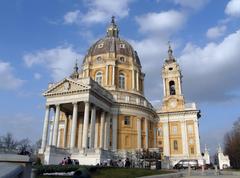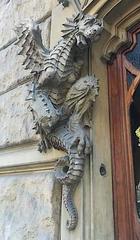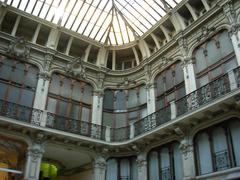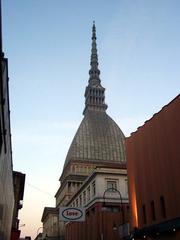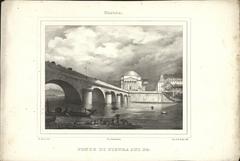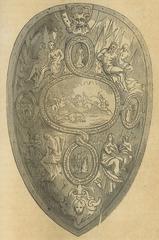
Visiting Piazza San Carlo in Chieri: History, Tips, and Visitor Information
Date: 17/07/2024
Introduction
Piazza San Carlo in Chieri, Italy, is an exquisite blend of history, architecture, and cultural vibrancy. Nestled in the picturesque hills near Turin, this piazza has evolved from a medieval marketplace to a symbol of civic pride and religious devotion. Visitors to Piazza San Carlo can immerse themselves in the rich tapestry of Chieri’s past, experiencing firsthand the architectural grandeur of the Baroque period and the lively atmosphere that continues to thrive today. This comprehensive guide will explore the historical significance of Piazza San Carlo, provide practical visitor information, and highlight nearby attractions to ensure a memorable visit. Whether you’re a history enthusiast, an architecture aficionado, or simply seeking a charming Italian getaway, Piazza San Carlo in Chieri promises an unforgettable experience (Visiting Piazza San Carlo in Chieri - History, Tickets, and Tips) (Exploring Piazza San Carlo - Visiting Hours, Tickets, and Architectural Insights in Chieri).
Table of Contents
- Introduction
- Historical Background and Significance
- Visitor Information
- Exploring Piazza San Carlo
- Nearby Attractions
- Conclusion
- FAQs
Historical Background and Significance
From Medieval Marketplace to Symbol of Civic Pride
The piazza’s origins can be traced back to the medieval period. Originally known as Piazza del Mercato (Market Square), it served as the bustling heart of Chieri’s commercial activity. Here, merchants and traders converged, their stalls overflowing with local produce, textiles, and crafts. This lively exchange fostered a sense of community and fueled the town’s economic growth.
Over the centuries, the piazza underwent transformations that mirrored Chieri’s evolving identity. It transitioned from a purely commercial hub to a space reflecting civic pride and religious devotion. This shift is evident in the architectural grandeur that began to grace its perimeter.
Architectural Gems Reflecting Changing Times
One of the most significant transformations occurred in the 14th century with the construction of the Church of San Carlo. This architectural masterpiece, from which the piazza derives its present name, became a dominant presence, its elegant facade shaping the square’s character. The church stands as a symbol of Chieri’s religious fervor during the Counter-Reformation era.
Further enhancing the piazza’s allure is the Palazzo della Città, or Town Hall. Dating back to the 13th century, this building has borne witness to countless civic events and decisions that shaped Chieri’s destiny. Its presence underscores the piazza’s role as the center of local governance and community life.
A Stage for History to Unfold
Throughout its existence, Piazza San Carlo has been more than just a backdrop; it has been a stage where history has unfolded. From joyous celebrations to moments of solemn remembrance, the piazza has absorbed the collective emotions of generations.
The echoes of market cries have given way to the harmonious tunes of festivals and processions. The footsteps of merchants have been succeeded by the measured strides of dignitaries and the playful scampering of children. Each generation has woven its own experiences into the fabric of the piazza, creating a rich tapestry of memories.
Visitor Information
Visiting Hours and Tickets
Piazza San Carlo is open to the public 24/7, making it accessible at any time of the day. While there is no entrance fee for the piazza itself, some of the surrounding attractions, like the Church of San Carlo, may have specific visiting hours and ticket prices. It’s advisable to check the official websites for the most up-to-date information.
Travel Tips
- Getting There: Chieri is well-connected by public transportation. You can reach Piazza San Carlo via local buses or by taking a short train ride from Turin.
- Best Time to Visit: The piazza is beautiful year-round, but visiting during local festivals provides a unique experience.
- Nearby Attractions: Don’t miss other historical sites in Chieri, such as the Duomo di Chieri and the Museo del Tessile.
- Accessibility: The piazza is wheelchair accessible, with smooth pathways and ramps available for ease of movement.
Special Events and Guided Tours
Piazza San Carlo hosts various events throughout the year, from religious processions to cultural festivals. Guided tours are available and offer a deeper insight into the history and architecture of the site. Photography enthusiasts will find plenty of picturesque spots around the piazza, especially during early morning or late afternoon when the lighting is ideal.
Exploring Piazza San Carlo
The Baroque Grandeur of Piazza San Carlo
The architectural language of Piazza San Carlo speaks eloquently of the Baroque period, a time when art and architecture celebrated grandeur and drama. Key elements of this style are prominently displayed:
- Dramatic Curves and Asymmetry: Unlike the balanced symmetry of Renaissance architecture, Baroque buildings embrace dynamic curves and playful asymmetry. This is evident in the flowing lines of the facades and the intricate details that adorn them.
- Sense of Movement and Theatricality: The buildings seem to reach out and engage with the space, creating a sense of movement and theatricality. This is heightened by the use of light and shadow, which play across the facades throughout the day.
- Rich Ornamentation and Detail: Baroque architecture is known for its lavish ornamentation. Piazza San Carlo doesn’t disappoint, with its buildings adorned with intricate carvings, sculptures, and decorative elements that showcase the craftsmanship of the era.
Notable Architectural Gems
Several buildings stand as proud examples of Baroque architecture in Piazza San Carlo:
- Collegiata di San Giovanni Battista (Chieri Duomo): Dominating the piazza, the Duomo, with its imposing facade and soaring bell tower, is a masterpiece of Baroque design. The facade, a study in contrasts, features intricate carvings juxtaposed with smooth surfaces, creating a dynamic visual experience.
- Palazzo della Città (Town Hall): Facing the Duomo, the Palazzo della Città, with its elegant portico and rhythmic sequence of arches, embodies the Baroque love for grandeur and symmetry. The building’s design, while grand, maintains a sense of balance and harmony.
- Surrounding Buildings: The piazza is ringed by other notable buildings, each contributing to the overall Baroque ambiance. These structures, with their ornate balconies, wrought iron details, and pastel-colored facades, create a charming and picturesque setting.
Cultural Significance – The Heart of Chieri
Beyond its architectural splendor, Piazza San Carlo is the beating heart of Chieri. It’s a place where the town’s social fabric is woven, a stage for its cultural expressions:
- Social Hub: For centuries, Piazza San Carlo has been the town’s central gathering place. It’s where locals come to socialize, shop at the weekly market, or simply enjoy a coffee while watching the world go by.
- Festivals and Events: The piazza comes alive during festivals and events, with its open space transformed into a vibrant stage for processions, concerts, and celebrations. These events offer a glimpse into the town’s cultural vibrancy and traditions.
- Historical Context: Over the centuries, Piazza San Carlo has borne witness to Chieri’s history, from periods of prosperity to times of hardship. Its stones have absorbed the stories of the town and its people, making it a tangible link to the past.
Nearby Attractions
While visiting Chieri, consider exploring these nearby attractions:
- Chiesa di San Domenico: A beautiful Gothic-style church located just a short walk from Piazza San Carlo.
- Museo del Tessile: Discover the rich textile history of Chieri at this fascinating museum.
- Parco Regionale della Collina di Superga: A natural park offering scenic views and numerous hiking trails.
Conclusion
Piazza San Carlo stands as a testament to Chieri’s enduring spirit and rich heritage. Its architectural splendor and cultural significance make it a must-visit destination for anyone exploring the region. From the intricate details of Baroque masterpieces to the lively social hub it provides, the piazza reflects both the historical and contemporary essence of Chieri. Visitors can enjoy the harmonious blend of past and present, whether by participating in local festivals, exploring nearby attractions, or simply savoring a coffee while soaking in the ambiance. Piazza San Carlo offers a unique glimpse into the soul of Chieri, a town where history whispers from every corner, and the community thrives. Plan your visit today to experience this remarkable blend of history, culture, and vibrant life (Top Tips and Must-See Attractions in Chieri - Your Guide to Visiting this Historic Gem).
FAQs
Q: What are the visiting hours for Piazza San Carlo?
A: Piazza San Carlo is open 24/7, but specific attractions around the piazza may have their own visiting hours.
Q: Do I need to buy tickets to visit Piazza San Carlo?
A: The piazza itself is free to visit, but some surrounding attractions may require tickets.
Q: How can I reach Piazza San Carlo?
A: Piazza San Carlo is accessible via local buses and a short train ride from Turin.
Q: Are there guided tours available?
A: Yes, guided tours are available and can provide deeper insights into the history and architecture of the piazza.
Q: What other attractions are nearby?
A: Nearby attractions include the Duomo di Chieri and the Museo del Tessile.
References
- Visiting Piazza San Carlo in Chieri - History, Tickets, and Tips, 2024, Author source
- Exploring Piazza San Carlo - Visiting Hours, Tickets, and Architectural Insights in Chieri, 2024, Author source
- Top Tips and Must-See Attractions in Chieri - Your Guide to Visiting this Historic Gem, 2024, Author source


